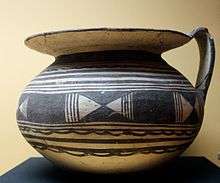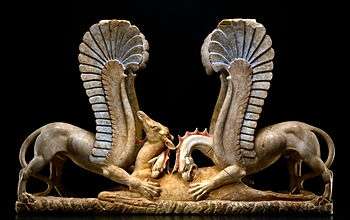Daunia
The Daunia is a historical and geographical region in Apulia, southern Italy, mostly coincident with modern Province of Foggia. Its inhabitants were called the Daunians by the ancient Greeks and were also known as the Daunii and the Apulians to the ancient Romans.[1] In ancient times, together with Peucetia and Messapia it formed the Iapygia.

Origins
Towards the late Bronze Age (11th-10th centuries BC), Illyrian populations from the eastern Adriatic arrived in Apulia.[2] The Illyrians in Italy, united with the pre-existing people and groups from the Aegean, probably from Crete, created the Iapygian civilization which consisted of three tribes: Peucetia, Messapi and the Dauni.[3] The region was previously inhabited by Italic peoples of Southern Italy; among them are the Ausones/Oscans, Sabines, Lucani, Paeligni, Bruttii, Campanians, Aequi, Samnites and Frentani.
The Dauni were similar to but also different from the Peucetii and Messapii, who settled in central and southern Puglia.[3] Having been also less influenced by the Campanian civilization, it had thus a more peculiar culture, featuring in particular the Daunian steles, a series of funerary monuments sculpted in the 7th-6th centuries BC in the plain south of Siponto, and now housed in the National Museum of that city. Particularly striking is Daunian pottery (as yet little studied) which begins with geometric patterning but which eventually includes crude human, bird and plant figures.
The main Daunian centers were Teanum Apulum (within the modern San Paolo di Civitate), Uria Garganica, the location of which though is not known with certainty, Casone, Lucera, Merinum (Vieste), Monte Saraceno (near Mattinata), Siponto, Coppa Navigata, Cupola, Salapia (near Cerignola and Manfredonia), Arpi (near Foggia), Aecae (near Troia), Vibinum (Bovino), Castelluccio dei Sauri, Herdonia (Ordona), Ausculum (Ascoli Satriano), Ripalta (near Cerignola), Canosa di Puglia, Melfi, Lavello and Venosa.
Etymology
The ethnonym is connected to the name of the wolf, plausibly the totemic animal of this nation. The cult of the wolf was widespread in ancient Italy and was related to the Arcadian mystery cult. In fact, daunos means wolf, according to ancient glosses, and is the correspondent of Greek taunos from an Indo-European root *dhau- to strangle, meaning literally strangler. Among the Daunian towns one may mention Lucera (Leucaria) and among other nations the ethnonym of the Lucani (Loucanoi) and of that the Hirpini, from another word meaning wolf. The outcome of the Proto-Indo-European voiced aspirate dh is proper of the Illyrian languages and so is different from the corresponding Latin faunus and Oscan, which is not attested.
Presence in ancient Italy
There are numerous testimonies among ancient authors (Pseudo-Scylax, Vergil, Festus, Servius) of a presence of the Daunians beyond the Apennines in Campania and Latium where some towns claimed Diomedian origins. The most notable instance is Ardea, the centre of the Rutulians who were considered Daunians: Vergil writes that Turnus' father was Daunus. Festus writes that a King Lucerus of Ardea fought along with Romulus against Tatius and this is the origin of the name of the Roman Luceres.[4]

See also
References
- ↑ Justin 1997, p. 192; Strabo 1924, 6.3.1.
- ↑ Charles Anthon A Classical Dictionary: Containing the Principle Proper Names Mentioned in Ancient Authors - Part One (Daunia, page 417) ISBN 1-4191-7384-7
- 1 2 "The origins of the Daunia civilization and the early Iron Age". ICCD (Istituto Centrale per il Cataklogo e la Documentazione.
- ↑ Briquel, Dominique (1974). "Le problème des Dauniens". Mélanges de l'Ecole française de Rome. Antiquité. 86 (1): 16.
Sources
- Primary sources
- Justin (1997). Yardley, J. C.; Heckel, Waldemar, eds. Epitome of the Philippic History of Pompeius Trogus. 1. Oxford: Oxford University Press. ISBN 978-0-198-14907-1.
- Strabo (1924). Jones, H. L., ed. Geography. 3. Cambridge, Massachusetts: Harvard University Press. ISBN 978-0-674-99201-6.
- Secondary sources
- Infante, Renzo, I cammini dell'angelo nella Daunia tardoantica e medievale (Bari, Edipuglia, 2009) (Bibliotheca Michaelica, 4).